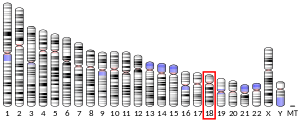FAM69C
Family with sequence similarity 69, member C is a protein that in humans is encoded by the FAM69C gene.[5]
| DIPK1C | |||||||||||||||||||||||||
|---|---|---|---|---|---|---|---|---|---|---|---|---|---|---|---|---|---|---|---|---|---|---|---|---|---|
| Identifiers | |||||||||||||||||||||||||
| Aliases | DIPK1C, C18orf51, family with sequence similarity 69 member C, divergent protein kinase domain 1C, FAM69C | ||||||||||||||||||||||||
| External IDs | OMIM: 614544 MGI: 3041188 HomoloGene: 45477 GeneCards: DIPK1C | ||||||||||||||||||||||||
| |||||||||||||||||||||||||
| |||||||||||||||||||||||||
| Orthologs | |||||||||||||||||||||||||
| Species | Human | Mouse | |||||||||||||||||||||||
| Entrez | |||||||||||||||||||||||||
| Ensembl | |||||||||||||||||||||||||
| UniProt | |||||||||||||||||||||||||
| RefSeq (mRNA) | |||||||||||||||||||||||||
| RefSeq (protein) | |||||||||||||||||||||||||
| Location (UCSC) | Chr 18: 74.43 – 74.46 Mb | Chr 18: 84.72 – 84.74 Mb | |||||||||||||||||||||||
| PubMed search | [3] | [4] | |||||||||||||||||||||||
| Wikidata | |||||||||||||||||||||||||
| |||||||||||||||||||||||||
Function
This gene encodes a member of the FAM69 family of cysteine-rich type II transmembrane proteins. These proteins localize to the endoplasmic reticulum but their specific functions are unknown.
gollark: It's like passwordless sudo on the brain.
gollark: Don't say for reasons, say for national security.
gollark: And remote kilswitches.
gollark: And PotatOS.
gollark: Just require them to submit their neural interface at the border to put a Copy.of the constitution on it.
References
- GRCh38: Ensembl release 89: ENSG00000187773 - Ensembl, May 2017
- GRCm38: Ensembl release 89: ENSMUSG00000047992 - Ensembl, May 2017
- "Human PubMed Reference:". National Center for Biotechnology Information, U.S. National Library of Medicine.
- "Mouse PubMed Reference:". National Center for Biotechnology Information, U.S. National Library of Medicine.
- "Entrez Gene: Family with sequence similarity 69, member C".
Further reading
- Tennant-Eyles AJ, Moffitt H, Whitehouse CA, Roberts RG (March 2011). "Characterisation of the FAM69 family of cysteine-rich endoplasmic reticulum proteins". Biochemical and Biophysical Research Communications. 406 (3): 471–7. doi:10.1016/j.bbrc.2011.02.076. PMID 21334309.
This article incorporates text from the United States National Library of Medicine, which is in the public domain.
This article is issued from Wikipedia. The text is licensed under Creative Commons - Attribution - Sharealike. Additional terms may apply for the media files.



